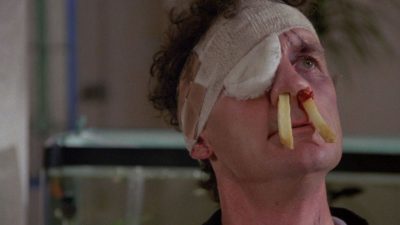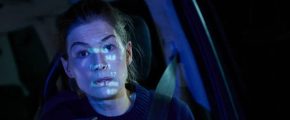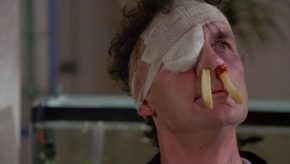Sometimes I think dark humour was the only way for people to survive the Stalinist regime. How else would have it been possible to enrich our culture with a Master and Margarita, or with The Witness, an iconic Hungarian film depicting an antihero’s struggle through a show trial? But I never asked the question whether it is possible to make something similar to these on the basis of performance, where movements play a bigger role than words do. This is what Belgian artist Alexander Vantournhout revealed during the interview – but we also discussed how it feels to be watched, what is the linking point between catacomb and acropolis, and what does a redhead have to do with Stalinist dictatorship.
Your new show is coming to Budapest soon. What can we know about it?
This is not my first time in Hungary; I have been to the Trafó before with a small piece called Raphaël. My partner in this was a dancer who played a dead body. It was a very tough but touching moment – some members of the audience even cried at the end. They projected a lot of personal feelings and experiences in the seemingly dead body lying on the floor. Then I made another piece, a solo called Aneckxander, based on my proportions, featuring male nudity and all self-consciousness related to that. After these two pieces, I wanted to do something that addresses a broader audience. In Red-Haired Men, we combine all kinds of different art forms, like magic, puppetry, circus, and dance.

This is the first group piece I bring to Budapest, and I wanted to use some external inspiration to bring the all the freelancer members together and decentralize the whole process a little bit. So Daniil Kharms’ written works became the basis, and as I expected, each member found an individual inspiration and interpretation. Actually, we only use five poems on stage; our piece is not text-centred. Red-Haired Men is one that I particularly like: it’s about a man who loses everything, even his body parts, until nothing is left. Like a little autobiography of Kharms himself.
Why is the poem autobiographical?
I read a lot about Kharms and can justify it. This sounds like a funny children’s poem, but at the same time, it has a much darker, brutal connotation. Kharms used to be a novelist during the Stalinist era, and he was sentenced to prison at one point. After he was released, he was only allowed to write for children, and then they even took that away from him. He died of starvation in a psychiatric hospital. This is what we tried to do with Red-Haired Men as well. There is a level that is very comical and funny, even adolescents (from, let’s say, age 12 on) can enjoy all the magic, puppetry, and circus we bring to the stage. But at the same time this is a political message as well, all of these funny poems and rhymes are political, although they don’t seem to be at first glance. We shouldn’t forget what Kharms went through, living his life in a dictatorship where he could never know which friend is the next to disappear.
This is something Hungarian audience can surely relate to. Have you also played this piece for audiences of other nationalities?
Yes, we toured quite a lot in France, and we also were in Belgium, the Netherlands, Switzerland. We are going to go to the Czech Republic, maybe to Montreal and to Denmark. This is the second season and we really look forward to doing it. I try to say a few words in the local language every time, so now I have to study the Hungarian language a bit. But as I said, the text is mostly there for inspiration.
What does the text inspire then?
For example, we have an acrobatic section in the show. To be precise though, what we try to do is ‘catabatics’. ‘Cata’ comes from catacomb and refers to the lower form of acrobatics. ‘Acro’ comes from acropolis, the hill where the gods live. You know, those people appear like superhumans, fly in the air or swing in an extreme height. What we do is more connected to the earth, to the floor. It is more like the opposite of playing superhumans: as we are closer to the audience, they can see the struggle on our face.
We are all dance acrobats – or ‘catabats’ – and look constantly forward, never leaving the gaze of the spectator. This is also a reference to the Stalinist totalitarianism where everyone had to constantly ‘look’ and be vigilant.
There are some repetitive parts in the show. For instance, the one where we use Mozart’s music. Everyone knows that little lullaby melody Twinkle, Twinkle, Little Star, but what people don’t really know is that Mozart wrote twelve beautiful variations for it. We use those in the piece. Again, it might appear as a childish and simple starting point, but it complexifies gradually, just like in the case of Kharms’ poems.
Does this have a genre?
Well, the main point of the whole show is that we mix so-called ‘lower art forms’ that don’t happen to be seen anymore, like magic, puppetry, and elements of classical circus. The team consists of members whom I know very well, so I knew what they can do and bring to the show. Winston Reynolds and Axel Guérin are dance acrobats whom I used to teach in their school, and there is Ruben Mardulier who is extremely skilled in various forms of puppetry, puppet opera, and visual arts.
So Red-Haired Men is neither a magic show nor a puppet show, but includes elements of both. It is also no classical theatre – we don’t have a storyline, more like pieces of narratives in the form of cabaret-like scenes. What we aim to do is to create an absurd universe rather than a coherent story. Nevertheless, it still has a hidden narrative that makes it different from traditional circus. What we need to emphasize, though, that it is more than a usual dance performance: we experiment with a new language, with new ways of moving.

Why do you find it important to make this distinction?
One of my biggest problems with contemporary dance is that performers don’t watch the audience anymore. I combined my frustration about this with a Kharms poem and the political connotation of ‘watch out for being watched’. Then we said: why shouldn’t we look at the audience for twenty minutes? I like venues where we are kind of dominated by the audience, like where the stage is on the same level where they are. It will work out very well in Trafó to awake feelings with the mere method of looking at people, as they are not used to that anymore. I remember, in Raphaël, my partner was only allowed to move his eyes during the entire piece – but that gaze he gave you really cut deep in your soul. We are determined to use all our methods featured in Red-Haired Men, from glances to movements, in a way that we not only entertain, dazzle or surprise the audience, but also awake deep emotions in them.

























Comments